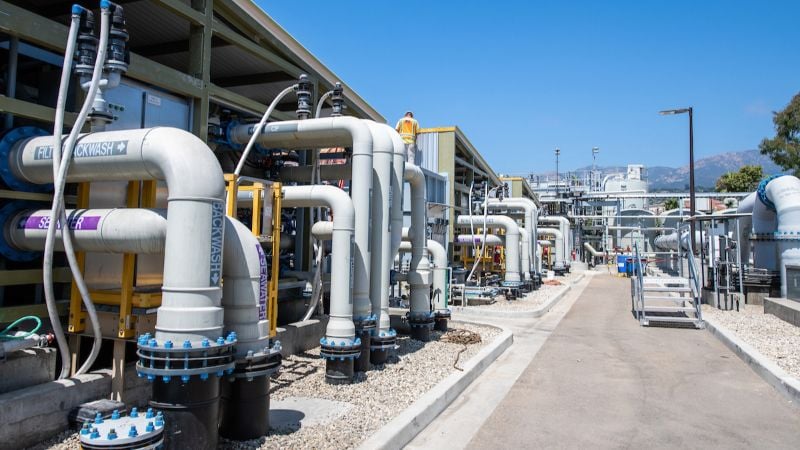Using Renewable Energy Storage for More Energy-Efficient Desalination Technology
NYU Tandon School of Engineering researchers have integrated energy storage with desalination to address the current shortcomings of water desalination technology.
Seawater desalination is a necessary process for providing fresh water in resource-constrained areas like the Middle East, North Africa, and Southern Europe. However, the technology is still plagued by power-hungry processes that drive up operational costs and limit its economic feasibility. This is even further exacerbated when the electricity used is derived from non-renewable and carbon-intensive sources.
Desalination plant in California. Image used courtesy of California Department of Water Resources
Understanding the Process and its Challenges
Desalination removes salt and other contaminants from seawater or brackish water, making it suitable for human consumption and other uses. The predominant technology in desalination is the reverse osmosis process, which employs high-pressure pumps to pressurize seawater and forces filtration through a semi-permeable membrane.
Unfortunately, reverse osmosis is notably energy-intensive, with most electricity demand attributed to the high-pressure pumps. When relying on non-renewable energy, desalination contributes to environmental harm, including increased carbon emissions, resource depletion, and limited sustainability. However, renewable energy sources are not quite ideal for powering desalination either.
Desalination is simply explained. Image used courtesy of The Jewish Federation of Greater Los Angeles
The major concern about renewable energy sources is their intermittent nature, which contributes to their variability in energy production. Renewable energy depends on factors like weather conditions, geography, and time of day. Consequently, using renewable energy alone cannot guarantee a consistent power supply, uninterrupted plant operation, and an effective solution to water shortages.
Integrating energy storage solutions could prove game-changing to address this intermittent nature. Besides allowing for a constant source of energy, this approach allows excess energy generated during peak production periods to be stored and utilized when renewable sources are unavailable. This ensures an affordable, consistent, and uninterrupted operation of desalination plants.
Integrating Renewable Energy and Storage with Desalination
The NYU Tandon team recently published a notable breakthrough in salt water desalination in Cell Reports Physical Science.
The team employed RFD, an electrochemical desalination process utilizing redox reactions to selectively remove ions from saline water. It involves water flow through electrochemical cells, where ion-selective membranes and redox-active species facilitate the removal of ions, resulting in desalinated water.
4-channel redox flow desalination system. Image used courtesy of NYU
The proposed system divides incoming seawater into the salinating stream (CH 2) and the desalinating stream (CH 3). Two additional channels (A) house the electrolyte and redox molecules, separated by a cation exchange membrane (CEM) or an anion exchange membrane (AEM). In CH 4, electrons move from the cathode to the redox molecule, extracting Na+ from CH 3. The redox molecule and Na+ are then transferred to CH 4, where electrons move from the redox molecules to the anode, enabling Na+ to diffuse into CH 2. Cl- ions move from CH 3 through the AEM to CH 2 under this potential, forming a concentrated brine stream. As a result, CH 3 generates a successful freshwater stream.
The battery gets charged during peak times by incorporating a redox flow battery in the path of electron flow (cathode to anode). It acts as a power source in the absence of renewable energy sources (solar or wind). The result improved the salt removal rate of an RFD system by approximately 20% while reducing energy demands by roughly 33%.
Advances in RFD
Water resource management is a global issue in the 21st century. NYU’s advancements in RFD promise to address immediate water scarcity issues and contribute to broader sustainability goals. In the future, integrating RFD into global water management strategies could play a pivotal role in providing reliable freshwater sources while reducing the cost and environmental impact of desalination processes.









